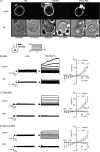A major interspecies difference in the ionic selectivity of megakaryocyte Ca2+-activated channels sensitive to the TMEM16F inhibitor CaCCinh-A01
- PMID: 31008669
- PMCID: PMC6816474
- DOI: 10.1080/09537104.2019.1595560
A major interspecies difference in the ionic selectivity of megakaryocyte Ca2+-activated channels sensitive to the TMEM16F inhibitor CaCCinh-A01
Abstract
TMEM16F is a surface membrane protein critical for platelet procoagulant activity, which exhibits both phospholipid scramblase and ion channel activities following sustained elevation of cytosolic Ca2+. The extent to which the ionic permeability of TMEM16F is important for platelet scramblase responses remains controversial. To date, only one study has reported the electrophysiological properties of TMEM16F in cells of platelet/megakaryocyte lineage, which observed cation-selectivity within excised patch recordings from murine marrow-derived megakaryocytes. This contrasts with reports using whole-cell recordings that describe this channel as displaying either selectivity for anions or being relatively non-selective amongst the major physiological monovalent ions. We have studied TMEM16F expression and channel activity in primary rat and mouse megakaryocytes and the human erythroleukemic (HEL) cell line that exhibits megakaryocytic surface markers. Immunocytochemical analysis was consistent with surface TMEM16F expression in cells from all three species. Whole-cell recordings in the absence of K+-selective currents revealed an outwardly rectifying conductance activated by a high intracellular Ca2+ concentration in all three species. These currents appeared after 5-6 minutes and were blocked by CaCCinh-A01, properties typical of TMEM16F. Ion substitution experiments showed that the underlying conductance was predominantly Cl--permeable in rat megakaryocytes and HEL cells, yet non-selective between monovalent anions and cations in mouse megakaryocytes. In conclusion, the present study further highlights the difference in ionic selectivity of TMEM16F in platelet lineage cells of the mouse compared to other mammalian species. This provides additional support for the ionic "leak" hypothesis that the scramblase activity of TMEM16F does not rely upon its ability to conduct ions of a specific type.
Keywords: Calcium; Scott syndrome; TMEM16F; megakaryocyte; phospholipid scrambling; platelet.
Figures


Similar articles
-
TMEM16F forms a Ca2+-activated cation channel required for lipid scrambling in platelets during blood coagulation.Cell. 2012 Sep 28;151(1):111-22. doi: 10.1016/j.cell.2012.07.036. Cell. 2012. PMID: 23021219 Free PMC article.
-
Ion channel and lipid scramblase activity associated with expression of TMEM16F/ANO6 isoforms.J Physiol. 2015 Sep 1;593(17):3829-48. doi: 10.1113/JP270691. Epub 2015 Jul 27. J Physiol. 2015. PMID: 26108457 Free PMC article.
-
TMEM16F is a component of a Ca2+-activated Cl- channel but not a volume-sensitive outwardly rectifying Cl- channel.Am J Physiol Cell Physiol. 2013 Apr 15;304(8):C748-59. doi: 10.1152/ajpcell.00228.2012. Epub 2013 Feb 20. Am J Physiol Cell Physiol. 2013. PMID: 23426967
-
Molecular functions of anoctamin 6 (TMEM16F): a chloride channel, cation channel, or phospholipid scramblase?Pflugers Arch. 2014 Mar;466(3):407-14. doi: 10.1007/s00424-013-1305-1. Epub 2013 Jun 8. Pflugers Arch. 2014. PMID: 23748496 Review.
-
Platelet membrane phospholipid asymmetry: from the characterization of a scramblase activity to the identification of an essential protein mutated in Scott syndrome.J Thromb Haemost. 2011 Oct;9(10):1883-91. doi: 10.1111/j.1538-7836.2011.04478.x. J Thromb Haemost. 2011. PMID: 21958383 Review.
Cited by
-
The binding of autotaxin to integrins mediates hyperhomocysteinemia-potentiated platelet activation and thrombosis in mice and humans.Blood Adv. 2022 Jan 11;6(1):46-61. doi: 10.1182/bloodadvances.2021004572. Blood Adv. 2022. PMID: 34559203 Free PMC article.
-
TMEM16 proteins: Ca2+‑activated chloride channels and phospholipid scramblases as potential drug targets (Review).Int J Mol Med. 2024 Oct;54(4):81. doi: 10.3892/ijmm.2024.5405. Epub 2024 Aug 2. Int J Mol Med. 2024. PMID: 39092585 Free PMC article. Review.
-
Molecular mechanisms of ion conduction and ion selectivity in TMEM16 lipid scramblases.Nat Commun. 2021 May 14;12(1):2826. doi: 10.1038/s41467-021-22724-w. Nat Commun. 2021. PMID: 33990555 Free PMC article.
-
Polymodal Control of TMEM16x Channels and Scramblases.Int J Mol Sci. 2022 Jan 29;23(3):1580. doi: 10.3390/ijms23031580. Int J Mol Sci. 2022. PMID: 35163502 Free PMC article. Review.
References
-
- Zwaal RF, Schroit AJ.. Pathophysiologic implications of membrane phospholipid asymmetry in blood cells. Blood 1997;89(4):1121–1132. - PubMed
MeSH terms
Substances
LinkOut - more resources
Full Text Sources
Miscellaneous
